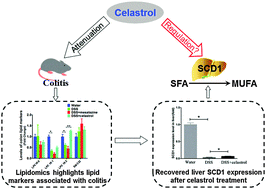A lipidomics investigation into the intervention of celastrol in experimental colitis†
Abstract
Celastrol is well known for its anti-inflammatory and anti-cancer effects. In this study, the efficacy of celastrol against dextran sulfate sodium (DSS)-induced inflammatory bowel disease (IBD) in mice was established and the mechanism was investigated using lipidomics. Celastrol treatment significantly alleviated DSS-induced colitis in mice, as revealed by the body weight, colon length, scores of rectal bleeding and diarrhea, serum TNF-α level, and histological analysis results. Lipidomics analysis based on UPLC/MS revealed characteristic changes in the metabolic profiles of the colitis mice, with altered levels of lipid markers associated with IBD, including LPC18 : 0, LPC18 : 1, LPC18 : 2, sphingomyelin (SM), and increased LPC18 : 0/LPC18 : 1 and LPC18 : 0/LPC18 : 2 ratios. For the celastrol-treated colitis mice, however, levels of the above lipid markers were restored, together with recovered saturated LPC/unsaturated LPC ratios. Accordingly, using GC–MS analysis, increased stearic acid (C18 : 0)/oleic acid (C18 : 1) and stearic acid (C18 : 0)/linoleic acid (C18 : 2) ratios were observed in colitis mice, which were later recovered after celastrol treatment. Quantitative real-time PCR analysis revealed that the liver expression of stearoyl-coenzyme A desaturase 1 (SCD1), the key enzyme controlling the desaturation of saturated fatty acid, was dramatically inhibited in IBD mice, and was obviously recovered after celastrol treatment. These results suggest that the increased saturated LPC/unsaturated LPC (and saturated fatty acid/unsaturated fatty acid) ratios associated with SCD1 down-regulation could be regarded as biomarkers of colitis, and celastrol alleviates DSS-induced colitis partially via up-regulation of SCD1, restoring the altered balance between stearic acid- and oleic acid-derived lipid species, which plays an important role in alleviating colitis. In all, this study provided the scientific basis for further development of celastrol in treating IBD.


 Please wait while we load your content...
Please wait while we load your content...